Download PDF
Download page Comparison of Results.
Comparison of Results
- In the Lehigh_River_Streamflow_Calcs.dss file, select the 2 computed FLOW-UNREG records.
- Open the CWMS_Events_Unreg_Output.dss file and select the the only record in the file.
- Click the plot button.
- Use the magnifying glass button to zoom in to an event.
Question: How do the results of the two hydrologic routing methods compare to the unregulated output from HEC-HMS?
The two hydrologic routings produced similar peak discharges during the 6 flood events, as seen in the table below. The peak flows resulting from the hydrologic routing are lower than those produced from the HEC-HMS unregulated outputs. The difference in peak flow is less than 10% for all events except January 1996. The inflow to F.E. Walter Dam during the January 1996 event was computed using daily average reservoir pool elevation data. The computed peak inflow to Walter Dam occurs approximately 18 hours after peak flow at Lehighton. There is a considerable amount of uncertainty associated with the computed inflow to F.E. Walter Dam and quality control of data records is important. Therefore, the unregulated flow was re-computed using simulated inflow to Walter Dam. Both sets of unregulated hydrographs are presented below. Notice that the unregulated hydrographs computed using the simulated inflow (dotted lines) contain a single peak while the unregulated hydrographs computed using the computed inflow (solid lines) contain a double peak. This is the result of the difference in timing of the computed and simulated inflow hydrographs.
The unregulated flow hydrographs computed using the reservoir holdout method produce higher discharges during the recession portion of the hydrograph than the other two methods. This is because negative holdout methods were screened, which created mass. For the Lehighton gage, the negative holdout values occurred during hydrograph recession and did not affect peak discharges. However, routing holdouts may not be an appropriate method if negative holdouts occur near the peak discharge or if the unregulated flows will be used for a volume frequency analysis.
| Events | Peak Flow (cfs) | ||
|---|---|---|---|
| Routing Inflow and Outflow | Routing Holdouts | HMS Unregulated Outputs | |
January 1996 (computed F.E. Walter inflow) | 29,300 | 29,300 | 40,400 |
January 1996 (simulated F.E. Walter inflow) | 39,500 | 34,700 | 40,400 |
| September 2004 | 44,600 | 45,000 | 48,400 |
| March-April 2005 | 34,800 | 34,800 | 38,400 |
| June 2006 | 44,900 | 44,900 | 45,100 |
| March 2011 | 31,700 | 31,600 | 31,900 |
| September 2011 | 19,900 | 19,900 | 20,000 |
The results for the Jan 1996, September 2004, March-April 2005, June 2006, March 2011, and September 2011 events are shown below. Within each figure:
- The dashed red line corresponds to the unregulated flow time series using meteorologic boundary conditions (from the CWMS modeling effort)
- The solid cyan line corresponds to the unregulated flow time series computed using gage recorded inflow and outflow
- For the Jan 1996 event figure, the dashed cyan line corresponds to the unregulated time series computed using simulated inflow and gage recorded outflow
- The solid blue line corresponds to the unregulated flow time series computed using reservoir holdouts (computed from gage recorded inflow and outflow)
- For the Jan 1996 event figure, the dashed blue line corresponds to the unregulated flow time series computed using reservoir holdouts (computed from simulated inflow and gage recorded outflow)
- For the Jan 1996 event figure, the dashed blue line corresponds to the unregulated flow time series computed using reservoir holdouts (computed from simulated inflow and gage recorded outflow)
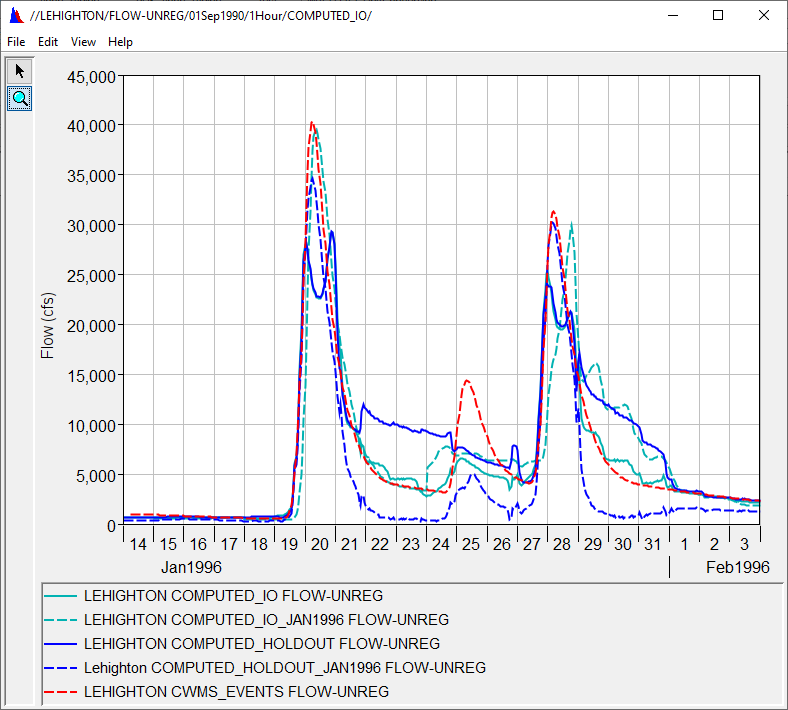
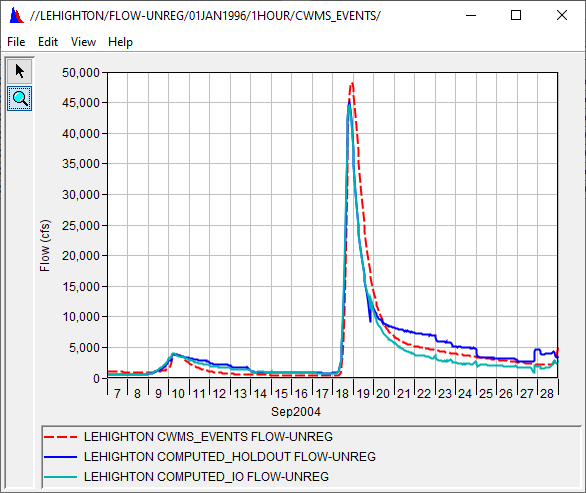
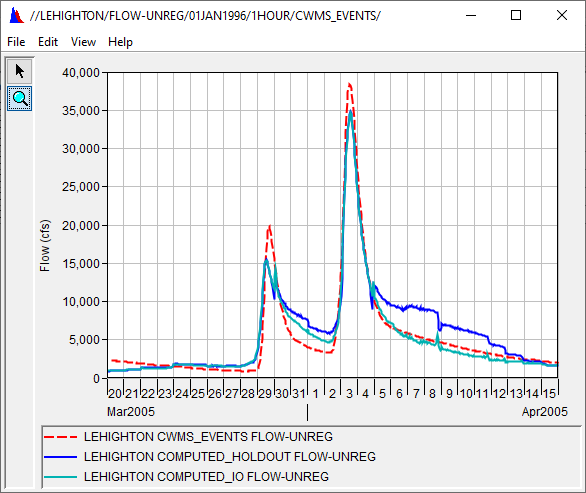
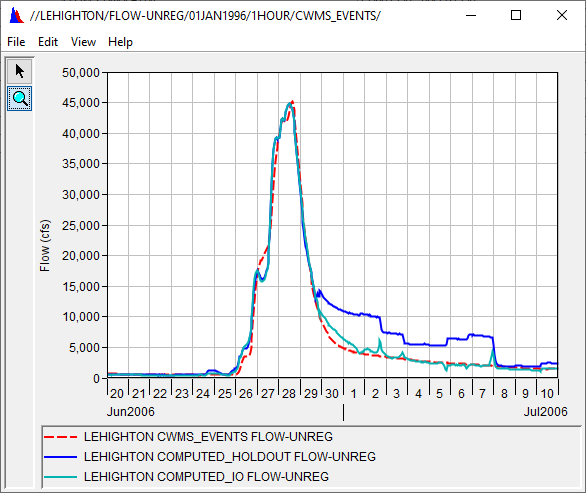
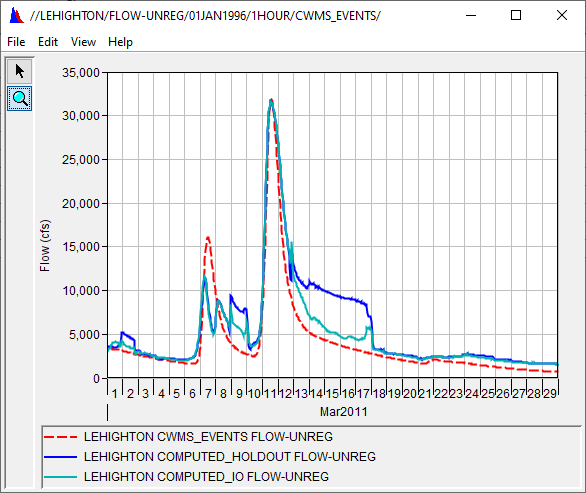
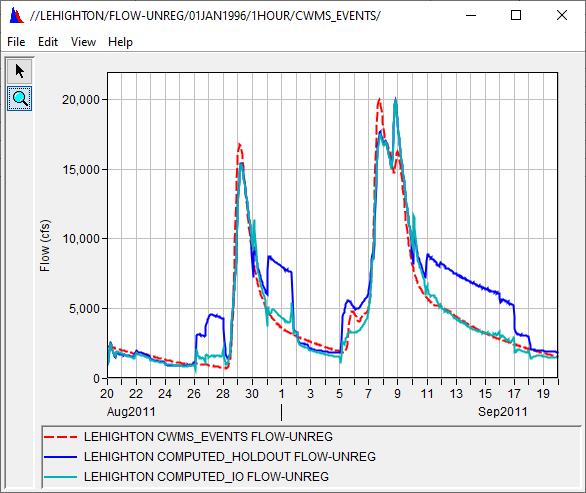
Summary
The unregulated streamflow record can be used for several types of analyses including, but not limited to, the following:
- An annual maximum series can be extracted for use in a Bulletin 17C flow-frequency analysis: Developing Flow and Volume Frequency Curves.
- The time series of historic unregulated streamflow can be used in HEC-ResSim to evaluate different regulation schemes at F.E. Walter Dam in a deterministic way.
- The time series of historic unregulated streamflow can be used in the HEC-WAT Hydrologic Sampler to randomly sample from a "bucket" of historical flood events in order to generate flood hydrographs.
- The time series of historic unregulated streamflow can be used to compute flood damages prevented for a given year.
